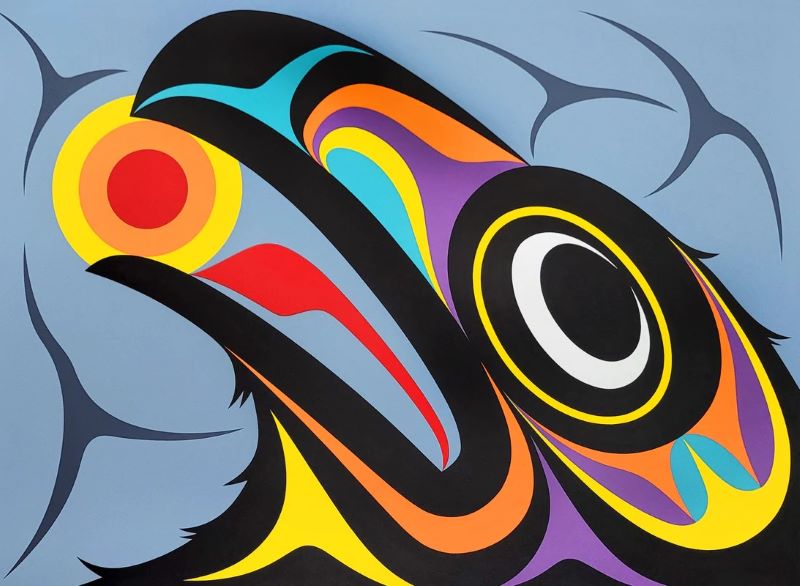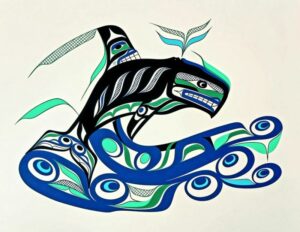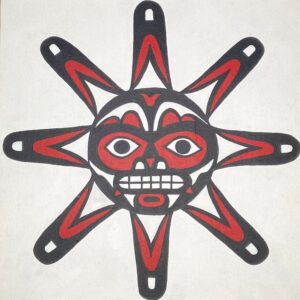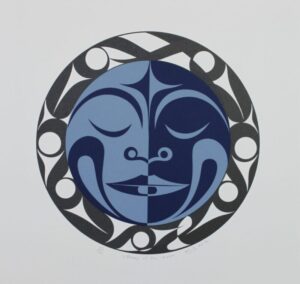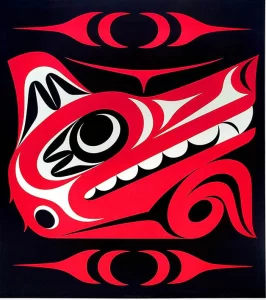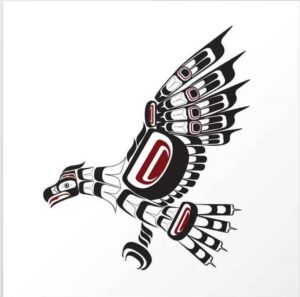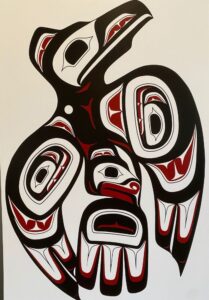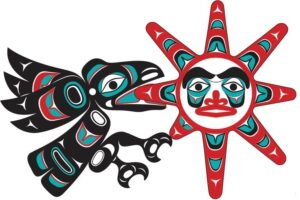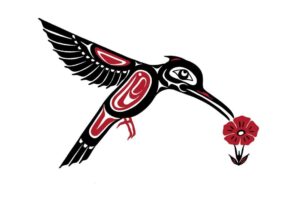The North West Coast of British Columbia and in particular Vancouver Island is rich in the history of its indigenous people. These people have been living in harmony with nature for thousands of years and tell tales through their artwork and legends.
Killer Whale
Find the Orca carved in wood, silver, gold or in print at Nicol Street Pawnbrokers.
The legend of the Killer Whale is a tale of Natcitlaneh who was abandoned on an island by his brothers-in-law who were jealous of his prowess as a hunter. He was rescued by the Sea Lions and taken to their village in a cave where he healed their Chief. In gratitude, the Sea Lions gave him supernatural powers enabling him to carve eight wooden Killer Whales. These Whales came to life when they were placed in the sea and avenged him by killing his brothers-in-law. As a mark of respect, Natcitlaneh built a house and named it Killer Whale House. According to the legend, the ancestors visited the house located at the bottom of the ocean to obtain the rights to use the Killer Whale as a crest.
It is said that the Orca is the reincarnation of a chief. When a chief dies and the Orca is seen near the village, it is often thought that it is the chief checking in on his tribe to ensure their well-being.
Held in great awe for its power and size, it was believed a Killer Whale could capture a canoe and take it underwater to transform the occupants into Whales. Thus a Whale near the shore was a human transformed and trying to communicate with his family. The Killer Whale’s song is said to be so beautiful that all creation is said to stop and listen to it. It is also said that to be splashed by a killer whale is to ensure great luck and happiness.
The Whale is a popular symbol for romance as they mate for life. The Whale, like the Wolf, stays with its family and travels in large pods. Indeed, the Killer Whale is said to have originated from a single great white wolf that lept into the sea and transformed itself into a Killer Whale. That is why they have white markings on their sides, travel in packs and are such skilled hunters. Another explanation for the white markings on the killer whale is the legend of the Killer Whale falling and Osprey when the killer whale was all black. Killer Whale and Osprey loved each other and Killer Whale would jump into the air to be closer to Osprey who in turn would fly low to the water to be closer to Killer Whale. The love was so great that when their child was born she was black and white, black like Killer Whale and white like Osprey.
The Sun
The Native Sun Symbol represents life-giving abundance with its warmth radiating healing and peace. The Sun was kept in one of three bags held by the grandfather in his great house. The Sun was freed and given back to the earth by the Raven, who through his trickery and cunning released it out of its confining box and flew through the chimney of the grandfather’s house. While holding the Sun in his mouth his beak and feathers were burned black.
Since then it has given all humankind warmth, light, and life. It was once believed that one could reach the sun by climbing a chain of arrows and that one would get down by sliding down the rays. The Raven is strongly connected to the heavenly bodies not only the sun, but the moon and the stars.
The Moon
Moon controls the tides and illuminates the dark night. Moon is also associated with transformation and is widely regarded as an important protector and guardian spirit. Because of the powers of the Moon, shamans sometimes call upon it as a spirit guide. In Alaska, Moon man is the master of animals.
The Nuu-chah-nulth (of Vancouver Island’s west coast), whose year features thirteen Moons, honour Moon, and his wife Sun, as the most powerful of beings, the bestowers of good luck and plentiful food. This is one of the instances in which the Moon is male and the Sun is female. Among other groups, personifications suggest that Moon is a female entity: she often wears a disk shaped lip labret of the type worn by high-ranking Haida women. Moon’s facial expression is more delicate and serene than Sun’s.
The son – Wulticixaiya – of Moon in a Haida (Queen Charlotte Islands) story rescues his sister from marriage to pestilence. Nuu-chah-nulth purification ceremonies were customarily undertaken during the waxing of the Moon. Moon plays a part in the peace dance of the Kwakwaka’wakw peoples (of northeastern Vancouver Island and the adjoining mainland), in which a human leaves the ceremonial big house and returns transformed into Moon. Moon also appears frequently in the winter ceremony of the Nuxalk.
Most tribes thank Raven for the gift of the Moon, and sometimes stories describe the Moon as a chip off of the Sun, which Raven clumsily dropped. Moon frequently appears grasped in the long straight beak of a Raven, in reference to the famous myths regarding the theft, and eventual release into the sky, of the Sun, and sometimes the Moon, by Raven.
One story of Raven and Moon, probably Salish, tells of its origin as a matchmaker:
Long ago in different villages by the sea, a young boy and girl grew into adults. Raven and Eagle knew the two would be perfect mates. Unfortunately, the paths taken by the young man and woman seldom crossed. He was an artist who spent his days in the forest searching for images to use in his carvings. She was a storyteller who stayed in her village teaching children. Raven and Eagle devised a plan to bring them together. They enticed each of them to take walks along the beach at night. It was a good plan and would have worked except that in those days there was no light in the night sky.
Every evening the two lovers to be passed in the dark; neither knowing the other was there. Undeterred Raven entered a camp and stole a burning log from the fire. It was heavier than he had expected. As he tried to fly away, it dragged along, leaving behind a bright streak of firelight on the surface of the sea. Eagle, seeing Raven’s problem, came to his aid using his strong wings to help lift the burning light high up into the night sky. There, it became a round flowing moon called Matchmaker. When the man came down to the sea, he was drawn towards the matchmaker’s light reflecting on the water. The young woman, starting from the other end of the beach, was also lured into the shimmering light. When the two met, they saw each other for the first time and illuminated by the matchmaker’s soft light, fell instantly in love. Raven and Eagle were very pleased. Ever since then, they have kept the Moon fire burning so that when lovers walk by the sea at night, they can still share matchmaker’s glow sparkling on the water.
The Raven is a mainstay in most West Coast Native legends and adorns many designs you will find at Nicol Street Pawnbrokers
The Wolf
The Wolf crest is a result of an ancestor who visited the houses of the wolves where he was taught certain songs and dances. Upon returning home, he discovered that he had been away for four years, although he thought it had only been four days. He found that he was possessed by the spirits of the Wolves.
In ceremonies, the Wolf dance portrayed the kidnapping for the original visit, and the remainder was a vivid dramatization of his rescue from the Wolf spirit influence. Of all the animals, Wolves have the strongest supernatural powers. They are the most proficient hunters of land animals and were greatly respected for their cleverness.
A whale hunter would paint a Lightning Snake on his canoe and then paint over it. The Lightning Snake has the head of a Wolf because it is revered for its cunning hunting prowess. Although it was unseen by the whale, the power of its presence on the canoe would aid the hunter to make a strike.
Since Wolves might bestow this hunting prowess on people, they were often called upon as spirit helpers. The Coast Salish believed that Wolves were the spirits of deceased hunters. The Kwagiulth considered them to be ancestors, and frequently impersonated them in religious ceremonies.
As Wolves mate for life and live in close family units usually travelling in packs, they are regarded as a family-oriented symbol in West Coast Native culture.
Wolf is the land manifestation of the Killer Whale as they both mate for life, protect their young and do not separate from their families.
The Bear
Bear is known as the protector of the animal kingdom. In Haida culture is referred to as “Elder Kinsman” and was treated like a high ranking guest when killed. Eagle down was sprinkled before it was brought in to the tribe to display respect.
In West Coast culture, there are several legends telling of a Chief’s daughter being abducted by a bear. The high ranking woman had been out in the woods picking berries and stepped on some Bear dung and began to curse out loud, insulting their cleanliness. Two Bears nearby heard her and decided they would not tolerate such insolence. They felt the disrespectful woman had to be punished. To do this, one Bear transformed himself into a very handsome man who approached this woman, and seductively lured her to accompany him to his mountain home. When she did, she fell in love with him and became partially Bear-like herself.
She later married him and had twin cubs. Their children were born as little creatures that resembled bears who could metamorphose themselves into human form like their father.
The woman’s brothers eventually found her and, in an unequal contest, killed her husband. They returned to the village but the two bear sons did not feel comfortable and eventually left to return to the forest. All Bear Clan members are descended from this woman and her two sons.
Because of this, it is believed that there is a bear within all of us and that we must come to terms with this in our lives.
The Eagle
The Eagle symbolizes friendship and peace and can be found represented in many pieces of Native Art at Nicol Street Pawnbrokers
The noble Eagle is seen as a symbol of power and prestige. Eagle also has a strong connection to peace. This species is still plentiful in the Pacific Northwest. They have long been a source of artistic inspiration for both traditional and contemporary Native artists.
The Eagle is considered an important Clan crest and is frequently depicted on totem poles, masks, prints and jewellry.
Eagle down, considered sacred, was used in ceremonies to welcome someone in friendship. “Down” was sprinkled on the ground before an important visitor came into the tribe. Eagle feathers are used for smudging and praying. The feathers were also given as a symbolic offering to bestow honour for acts of courage and wisdom.
The Cree consider each feather as having special meaning and distinction. They make up the Cree dancers regalia and must be earned one at a time.
The Raven
The Raven plays many roles in North West Coast Native legends and can be found in many designs at Nicol Street Pawnbrokers
The Raven is the transformer, trickster and creator. He is known in legends as the one who released the sun, moon, and stars; discovered man in a clamshell; brought the salmon and the water; and taught man how to fish and hunt.
Raven in Kwaguilth culture is known as the sky messenger of the animal kingdom. The Raven is famous for being a somewhat mischievous glutton. He was always out to please himself and have a good time, but his adventures always ended up bettering mankind.
The story of “Raven Steals the Lights” is legendary. An old man lived in a house on the bank of a river with his only child – a daughter. At this time, it was pitch black everywhere and no one could see anything. So whether she was beautiful or not, there wasn’t a way anyone could tell. Thus begins the tale of the Raven and the Sun. It’s said that the old man kept the Sun locked in a box inside a box, which had yet another box containing an infinite number of boxes until finally there was one so small that all it could contain was all the light in the universe.
The Raven was not satisfied with the state of darkness since it led to his blundering and bumping into everything. This slowed him down in his pursuit of the good things in life, which was what he loved more than getting into mischief. One day he crashed into the old man’s house and he heard the man and his daughter talking about the light. He decided he wanted the light for himself so he waited for the daughter to leave the house. He transformed himself into a pine needle to slip into a bucket of water. When the daughter drank the water and swallowed the pine needle, the Raven transformed himself into a tiny human being inside her. When he emerged, he was a very odd looking child, but it was too dark to noticed his long nose and the few feathers still clinging to him.
As the Raven/Child gained the affection of the old man, he devised a plan to get the Sun. He asked for the largest box in the house and upon being refused, he cried and screamed so loudly that the Grandfather gave him the box. After all it was only one and there were so many more. It took many days, but after a few well-executed tantrums the Raven/Child removed all the boxes. When only a few were left, a strange radiance began to suffuse the room. The Raven/Child begged to hold the light for only a few moments, and even though the Grandfather had come to love the Raven/Child with only a glimpse of him, he gave him the light. As the light was passed to him, the Raven/Child transformed into a huge Raven. He snapped up the light and flew up the smoke hole of the house into the darkness of the world.
The Hummingbird
A literal messenger of joy, this beautiful tiny bird, also called Sah Sen, represents friendship, playfulness, and is a symbol of good luck in Northwest Coastal Native art. It is a positive sign to see Sah Sen prior to a major event such as hunting or travelling to another village. Hummingbird’s ability to hover back and forth at great speeds is believed to be a skill for guiding the people; if they fall behind Hummingbird can easily back up to keep pace.
One story of Hummingbird tells of a warm, spring day. Summer was coming and the wild flowers were in full blossom. A young girl and her mother waded through the green grass, enjoying the bright colours. They stopped as Hummingbird joined them, buzzing and darting from flower to flower.
The little creature fascinated the child. She asked, “why does such a tiny bird want to fly so fast? Why doesn’t it just stay at one flower instead of visiting every one?” Her mother sat down on a hill overlooking the field and said, “let me tell you the story of Hummingbird.”
Many years ago there was a fragrant flower that rose every spring to display her beautiful petals and bright colours for all the world’s creatures to enjoy. The people and animals waited anxiously each spring for this special flower to appear. On that day they knew the warm, kind rays of summer had arrived. Raven saw how much joy this flower brought to the world, so the next spring when it appeared, he transformed it into a tiny bird. The bird had the colours of the green spring grass and the flashing red of a setting sun. Raven gave the bird a special gift, to fly like sunlight flickering through tall trees. He also gave it a message to take to all the flowers. That’s why today we see Hummingbird buzzing from flower to flower, whispering a message. Hummingbird is thanking each flower for making our world a more beautiful place.
The mother looked at her child and said, “as you grow up, remember that like each flower, each person has gifts to give the world. In return that person will be thanked by the birds, animals and flowers for helping to make our world a better place for every one.”
The Humming bird is also a symbol of health and healing. It is said that the Hummingbird will fly to the source of pain and heal all suffering.









